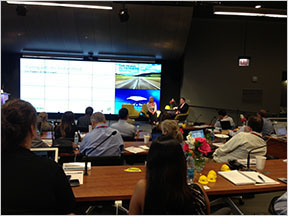
The last week in June, I got to be a part of a thrilling trifecta; all within 24 hours:
- I got to network with and learn from brilliant innovators (yah, you know who you are!);
- I visited, on-site with one of my favorite customers (WMS Gaming — their campus is stunning!);
- And, I was in one of my favorite cities (Chicago) during the big Stanley Cup win!
Read on for valuable information on how to structure an innovation program.
The folks at Brightidea did a super job picking the spectrum of presenters. It seemed that every speaker had a different approach to ideation as part of a larger innovation program. Some organizations have a casual, and yet highly effective approach that is geared toward company culture and the intake of good ideas (e.g. the prioritization of employee requests and product enhancements).Although it is impossible to forget two goals in 17 seconds, I will also never forget a few of the powerful concepts on ideation and innovation discussed at the Brightidea® Birds of a Feather Event.
Others have a much more structured, formal approach that focuses on an internal consulting group delivering “Innovation as a Service.” Still others described a coaching and supporting team within the company that was the “Office FOR Innovation” and not the “Office OF Innovation.” All of these different ways of organizing your innovation program to drive the desired results got me thinking: How do you determine the right structure for your company?
Now before you get too excited, please allow me to burst your bubble before we even begin — there are no one size fits all answers here. (Booo!) But I can give you a few hints and key considerations to get you thinking and moving in the right direction:
- Executive Leadership and Support — This is number one on the list because it is what drives your innovation program. If management isn’t propelling the program and instead is merely giving it a nod of approval, don’t try to go big and structured. Start small and produce some measurable results to get them salivating for more. Pushing an innovation program up the chain of command is extremely difficult, time consuming, and somewhat defeating. But executives are easy to hook with the right metrics and outcomes. As they start singing the praises of ideation, you can grow your program.
- Desired Innovation Outcome — Every company has different needs and desired goals when beginning their innovation journey. Match your program structure to your desired outcome. If you’re looking to simply tap into employee ideas to feed into the product pipeline, keep your structure light and unencumbered by heavy processes. If you’re looking to drive measurable, bottom line results that get reported to the street, consider something a little more formal.
- Company Culture — Culture is tricky. Sometimes you have to swim around in it for a bit to understand it clearly. If your company is successfully growing thanks to some mature cash cow products and driving innovation isn’t necessary to achieve corporate strategies, go back to consideration #2 and ask yourself what your end game is. Whatever you do, do NOT do innovation for innovation’s sake. It will just be a waste. If your culture lives and breathes innovation every day like the Apples, Googles, and Facebooks of the world, then I would challenge you — do you really need a program to try to harness it? Most of us fall somewhere in between these two extremes and need to carefully determine what type of structure will succeed and what will result in the circular file after the next hot new thing comes along.
- Tolerance for Process — Speaking of process, we all know it gets a bad name. Process doesn’t have to be restrictive and stiff. Your organization’s tolerance for process is a great litmus test to drive the level of structure for your program. If your folks roll your eyes at the launch of another new program, keep ideation informal and walk-up-and-use to keep adoption high. If they are more comfortable with process, you can consider going a little more formal with your rollout.
- Size of Organization — Companies, like people, come in all sorts of different shapes and sizes. Smaller teams require less formality and less structure. Larger teams require a little more thoughtfulness and infrastructure. Simply put, there is no need to use a sledge hammer for a pin nail.
- Risk Tolerance — If your group lives by the “go big or go home” paradigm, then go for it! Just be sensitive to those executive supporters and their comfort level. If risk tolerance is low, start with internal champions that will get your program off to a great start.
- Innovation Budget — This consideration is at the bottom of the list because it is the least important of the considerations. While I remind everyone (all the time) that innovation is not free, it also doesn’t have to be expensive. Scale your program based on what you have to spend but be clever about how you do it. And remember that the best things (and ideas) in life are free.
There are many other best practices to consider when launching your program, but these should get you started in the right direction. Socialize your plan or the changes to your existing program that have been swirling around in your head. And then shoot the puck into the goal so the crowd can go wild.
I’d love to hear from you! What is your organization doing to fuel innovation and what methods are you using to collect ideas? Share your recommendations by leaving a comment below.




